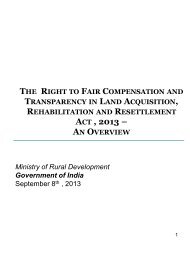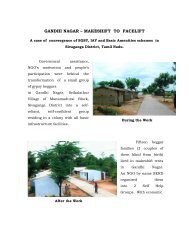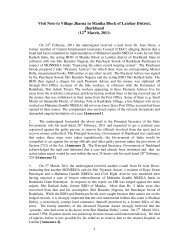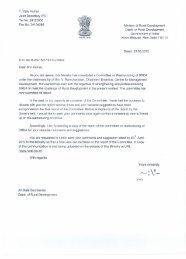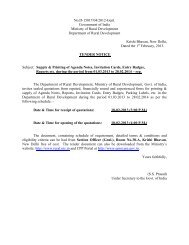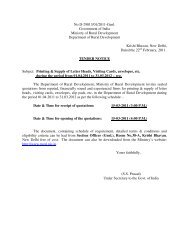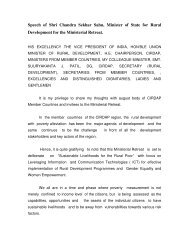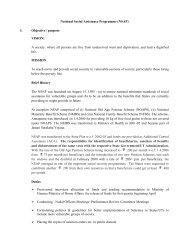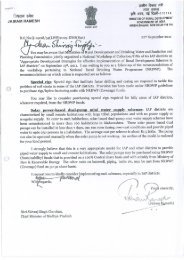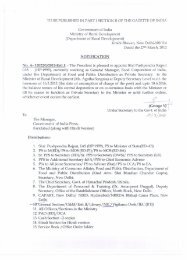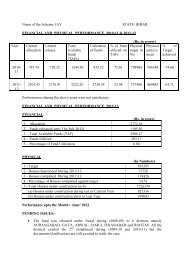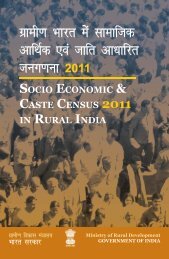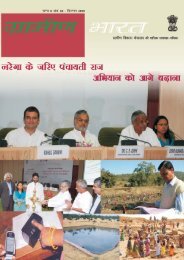UGC Report on Inter University Center on Rural - Ministry of Rural ...
UGC Report on Inter University Center on Rural - Ministry of Rural ...
UGC Report on Inter University Center on Rural - Ministry of Rural ...
You also want an ePaper? Increase the reach of your titles
YUMPU automatically turns print PDFs into web optimized ePapers that Google loves.
• 6. Policies are also required to take care <strong>of</strong> the victims <strong>of</strong> the bazaar, Special<br />
employment policies have to be integrated to the extent possible with paradigms <strong>of</strong><br />
broad based growth.<br />
Some Basics<br />
• Short run difficulties are nested in the more basic challenge <strong>of</strong> limits to growth<br />
imposed by scarcity <strong>of</strong> land and water resources.<br />
• Per capita arable land is more or less the same as that <strong>of</strong> China. “East Asian Societies<br />
have a c<strong>on</strong>cern for land scarcity which has come through decades. This is not<br />
happening in India”<br />
• There is little appreciati<strong>on</strong> <strong>of</strong> the fact that growth has to come now entirely from<br />
productivity improvement or increase in crop intensity.<br />
• In some quarters there are tendencie to escape into utopias like interlinking <strong>of</strong> rivers,<br />
multinati<strong>on</strong>al led c<strong>on</strong>tract farming replacing the raiyat . All such arguments may have<br />
an element <strong>of</strong> truth and yet are not the complete answer<br />
2.2 Knowledge as A Source <strong>of</strong> Growth<br />
The total land area <strong>of</strong> India is around 3.3 milli<strong>on</strong> square kilometers with 7000<br />
kilometers <strong>of</strong> coast line. The entire area is spread into deserts, hilltops, mountains, sea shores,<br />
islands, valleys and plains. Out <strong>of</strong> the billi<strong>on</strong> plus populati<strong>on</strong> in the country 70% live in six<br />
hundred thousand villages. We are in the process <strong>of</strong> a societal transformati<strong>on</strong> towards<br />
sustainable development for our growth. India has gained the reputati<strong>on</strong> <strong>of</strong> being a country<br />
with the greatest human resource potential. This claim is based <strong>on</strong> the fact that its science and<br />
technology man power will be a formidable force in the 21 st Century. Nature has also<br />
endowed this sub-c<strong>on</strong>tinent with lot <strong>of</strong> bio diversity, traditi<strong>on</strong>al knowledge, traditi<strong>on</strong>al<br />
wisdom etc. The greatest challenge therefore is to transform the informati<strong>on</strong> and know-how<br />
provided by extensive educati<strong>on</strong>al system and traditi<strong>on</strong>al wisdom into factors c<strong>on</strong>tributive to<br />
the social and market ec<strong>on</strong>omy.<br />
Technology policies are not covering the last mile as much as they should. In the area <strong>of</strong><br />
seeds for example there is now emphasis <strong>on</strong> the yield potential gap. Take the paddy hybrids.<br />
They seem to have finally taken <strong>of</strong>f with the Agriculture Secretary announcing coverage <strong>of</strong><br />
over four milli<strong>on</strong> hectares. China was doing well and by now was crossing ten milli<strong>on</strong><br />
hectares. We were stuck at less than a milli<strong>on</strong> for over a decade. With area sown going down<br />
and irrigated area stagnating, yield increase seems the <strong>on</strong>ly way out in the immediate future.<br />
Hybrid paddy has great promise.<br />
The research for hybrids in paddy started with a bang around a decade and a half ago. It was<br />
directed by Dr. E.S.Siddiqui. There were a number <strong>of</strong> centers where the seeds were<br />
developed. In others they were to be replicated. A nati<strong>on</strong>al network was set up. By the early<br />
Nineties around seven varieties were released in the South and East. The northern centers<br />
didn’t take <strong>of</strong>f. The KRH- IV in Karnataka gave a yield <strong>of</strong> eighty two quintals <strong>of</strong> paddy. The<br />
CNHR-III in Bengal for boro paddy was close at eighty <strong>on</strong>e and the APHR varieties between<br />
8



